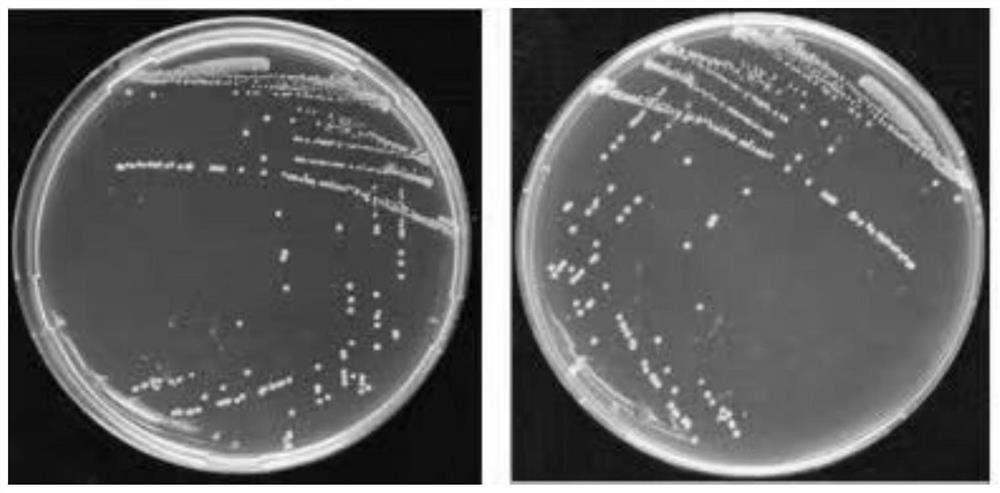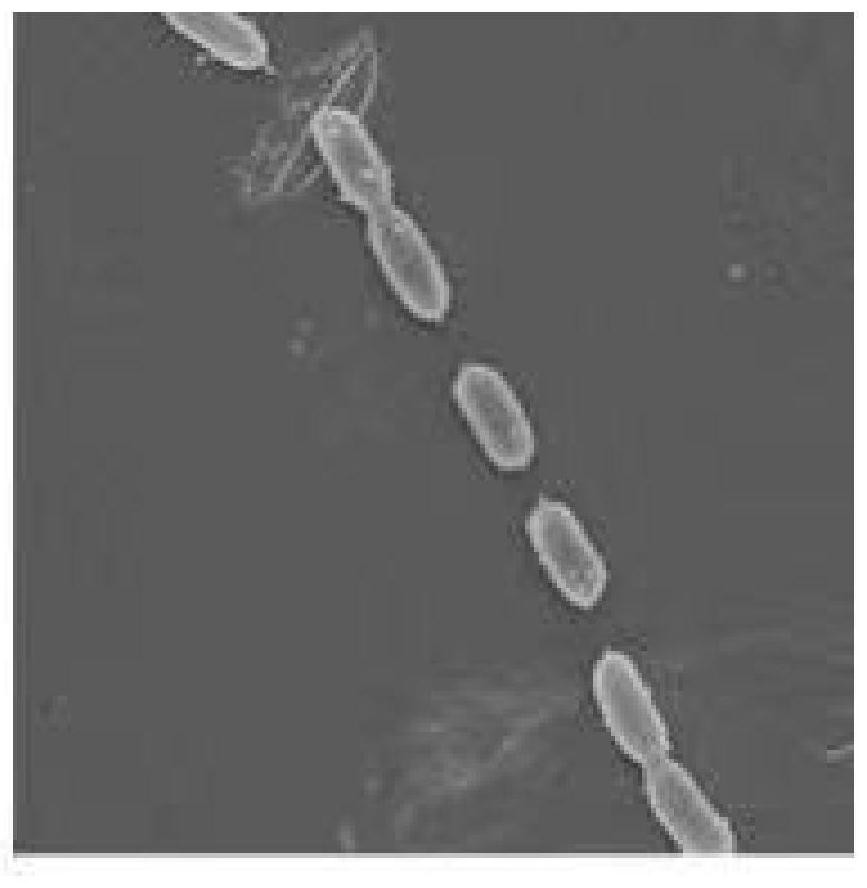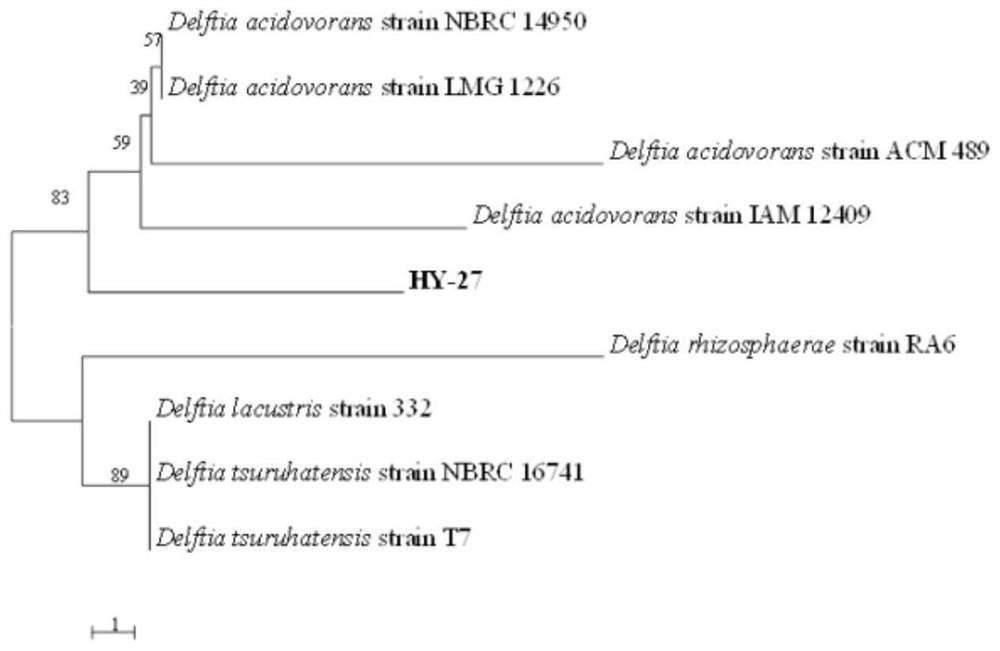Delftia acidovorans and application thereof in prevention and treatment of plant diseases
A technology for acid-eating bacteria and plant diseases, applied in applications, plant growth regulators, botanical equipment and methods, etc., can solve the problems of pathogenic bacteria resistance and food safety, antibiotic microbial resistance, chemical pesticide environmental pollution, etc. , to achieve obvious biological control effect, stable degradation effect, and reduce the effect of use
- Summary
- Abstract
- Description
- Claims
- Application Information
AI Technical Summary
Problems solved by technology
Method used
Image
Examples
Embodiment 1
[0048] Isolation and screening of embodiment 1 bacterial strain HY-27
[0049] 1. Soil sample collection:
[0050] Several soil samples were collected from Heyuan, and the samples were stored in a 4°C freezer for later use.
[0051] 2. Enrichment culture of bacterial strains:
[0052] Soil samples collected from Heyuan were used as microbial sources, and OHHL was used as the only carbon source for enrichment culture. Put 50mL of basal salt medium (MSM) into a 250mL Erlenmeyer flask, sterilize it, and add OHHL mother solution (with acetonitrile as solvent, the concentration is 100mM) under the ultra-clean workbench after cooling to make the final concentration 5μM ; Then add 5g soil sample respectively. After culturing for 7 days at 30° C. and 200 rpm, the inoculum was transferred to 50 mL MSM with a final concentration of OHHL of 10 μM at a 10% inoculum size. After culturing under the same conditions for 7 days, transfer 10% of the inoculum to 50 mL MSM with a final concen...
Embodiment 2
[0061] Identification of embodiment 2 bacterial strain HY-27
[0062] In this example, morphological identification, 16S rDNA phylogenetic analysis, and physiological and biochemical identification were carried out on the quenched bacteria HY-27, and the strain was identified as Delftia acidovorans. details as follows:
[0063] 1. Morphological characteristics of the colony: The colony of the quenched strain HY-27 in the LB solid plate has a large diameter, moist, translucent, irregular edges, and a point-like protrusion in the center. Such as figure 1As shown; when growing in LB liquid medium, it was diffusely turbid, and with the extension of culture time, the bacterial liquid changed from milky white to yellowish, and grew well at 28°C.
[0064] 2. Morphological characteristics of bacteria: such as figure 2 As shown, the bacterial cells are short rod-shaped with terminal flagella.
[0065] 3. 16S rDNA identification and phylogenetic analysis: Using the genome of strain...
Embodiment 3
[0067] Example 3 Detection of Degradation Activity of OHHL by Acidovorax Delft Strain HY-27
[0068] In this example, the reporter strain (Agrobacterium tumefaciens) CF11 was used to detect the degradation effect of strain HY-27 on OHHL.
[0069] Activate the strain HY-27 with LB solid medium plate, place the plate in an incubator at 28°C, and cultivate it for 48 hours. Pick a single colony and inoculate it into liquid LB medium, and culture overnight at 28°C and 200rpm to obtain a bacterial solution. Get OD 6oo The HY-27 cells with a value of 1.0 were inoculated into 1 mL of MSM inorganic salt medium, and MSM only contained OHHL as the sole carbon source. The concentration of OHHL in the reaction system was 40μmol / L. The reaction mixture is incubated under suitable conditions. Then take the reaction mixture and the bacterial liquid of the reporter strain Agrobacterium tumefaciens CF11 for spotting.
[0070] At the same time, Bacillus thuringiensis subsp. israelensis B23 ...
PUM
 Login to view more
Login to view more Abstract
Description
Claims
Application Information
 Login to view more
Login to view more - R&D Engineer
- R&D Manager
- IP Professional
- Industry Leading Data Capabilities
- Powerful AI technology
- Patent DNA Extraction
Browse by: Latest US Patents, China's latest patents, Technical Efficacy Thesaurus, Application Domain, Technology Topic.
© 2024 PatSnap. All rights reserved.Legal|Privacy policy|Modern Slavery Act Transparency Statement|Sitemap



